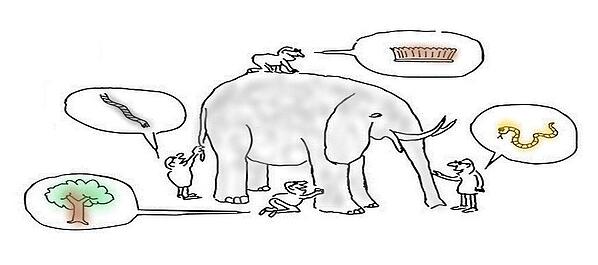In most technology companies, “go-to-market” is a throw away phrase; everyone from sales to finance uses it when it’s convenient. It is a catch-all phrase and often used as a placeholder for things related to target customers, product direction, marketing strategy, sales enablement, pricing and launch efforts.
The problem is that we put lots of things in the go-to-market bucket often with good intentions –
“We will address these once the UX and feature priorities settle down.”

At best, we only return to the bucket list 45 days before our major release or launch event. More than likely these assumptions are only reviewed when product sales and adoption results don’t match the plan. Trying to fix the go-to-market issue has more challenges; it is very much like the old fable of the sightless men assessing the elephant. How you assess the problem of go-to-market depends upon your point of view and what part of it you examine.
The discipline or practice of go-to-market is comprehensive, broad, and in some companies, fluid. Identifying gaps or holes in the process requires specific tools and methods to give a proper analysis.
The framework below is a tool we use at Egress Solutions with our clients to help them accurately and adequately assess which dials in their go-to-market need to be adjusted to get immediate and long-term benefit in the areas of product adoption and sales velocity. The framework is derived from seminal work such as Crossing the Chasm, Chasm Institute, and the GE-McKinsey Matrix.
Go-to-Market Execution Framework

A client we recently worked with found that after a large development effort to build comprehensive features for their Time-tracking application that adoption and usage of new features had failed.
They pulled key stakeholders together and believed that the root cause of the failure was due to a break down in their launch efforts. So, they doubled down on sales training, customer success training and more outbound messaging to their customers. However, these efforts did not significantly move the adoption needle for the product.
If the client would have used the GTM Strategy Framework they would have learned that putting more focus on their launch activities would never deliver an acceptable return on investment. We determined that the actual problem was misalignment with the target buyer’s motivation, and the client’s primary positioning and competitive approach. Their positioning was focused on offering a gain inefficiency while their buyer was motivated by reducing a specific set of pains such as penalties for non-compliance with local wage and labor laws.
It sounds simple to grasp but depending on which group or department in your company is accountable for go-to-market execution, these nuances can easily be lost or misunderstood.
The time has come for a framework view of go-to-market execution for the technology industry.
What is needed a straight forward and easy to implement 6-point assessment that brings the key stakeholders into alignment and helps sequence the work so that it happens as the product or feature enhancements are being designed, prototyped, built and acceptance tested. This is quite different from the typical check list approach that pushes all of the tasks and many of the assumptions into the go-to-market bucket until a few weeks prior to a major release of launch event.
At Egress Solutions Inc., we provide product management and product marketing consulting services that help our clients accelerate product sales growth and adoption. We would love to hear from you on your approach for go-to-market execution.

Other Related Content



